LG have
been a key player in the market for some time now, and have tended to
concentrate on TN Film based models over the last year or so. The screen we have
for testing at the moment is no exception, and fits nicely into their top end of the 22"
range. The LG L227WT attempts to offer all the leading specifications you could
want from the current 22" market. It offers a heavily overdriven response time
of 2ms G2G, a high dynamic contrast ratio of 5000:1 and a high colour gamut
thanks to its W-CCFL baklighting. Not surprisingly LG have aimed this particular
model at gaming and movie viewing. Let's start by taking a look at the product
specs:
|
Size |
22"WS |
Colour Depth |
16.7M (6-Bit+FRC), 100% NTSC colour gamut |
|
Resolution |
1680 x 1050 |
Viewing Angles |
170 / 170 |
|
Response Time |
2ms G2G |
Panel Technology |
TN Film |
|
Contrast Ratio |
5000:1 DRC |
Interfaces |
DVI (HDCP) and D-Sub |
|
Brightness |
300 cd/m2 |
Colour |
Piano black bezel and stand |
|
Special Features |
Tilt and pivot ergonomic adjustments, Dynamic
contrast ratio (DFC), extended colour gamut backlighting covering 100% NTSC
gamut, EZ-Zooming function |

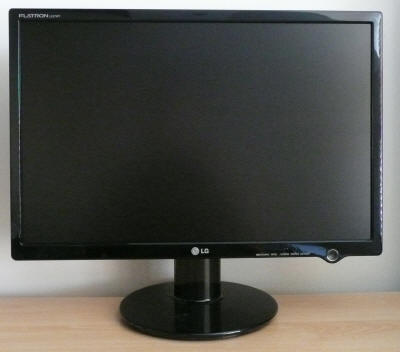
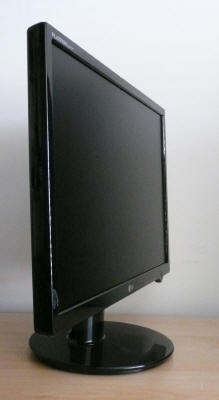
Above:
Front and side views of the L227WT. Click for larger versions
The design of the LG L227WT
is quite basic, but the screen is finished in an attractive glossy black
colour. The screen itself features a standard anti-reflective coating, rather
than any glossy finish. The bezel and base are reflective (making photogrphy difficult!) but
the screen looks nice in both home and office environments. The bezel is
pretty thin and the stand is reasonably sturdy. The materials are of a good
standard and apart from the screen being a little wobbly, build quality is
very good as you would expect from LG.
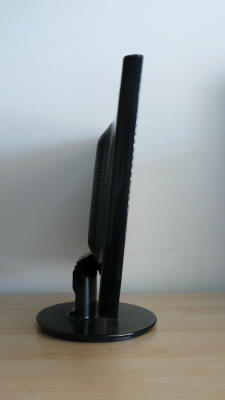

Above: Side
and rear view.
The stand clips into place
easily enough as it is disconnected in the package to help save room. The base does
offer a pivot function to allow the screen to be rotated easily enough, but
lacks any height or rotation adjustment. I think it's always useful to feature
a height adjustable stand, since not everyone will want the screen positioned
at the same height.
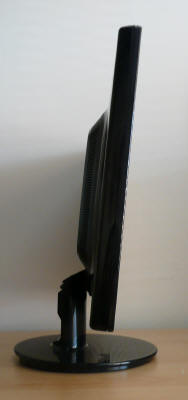
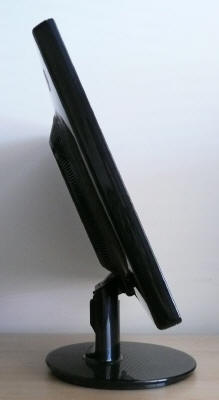
Above: Side
view showing full range of tilt adjustment. Click for larger versions
The tilt adjustment is quite
restricted, but at least it is there I suppose. The mechanism is quite stiff
as well, and there is only a small range in which the screen can be moved, as
shown above.
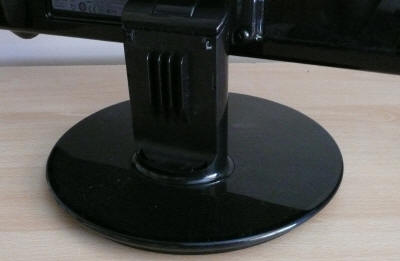
Above: View
of the stand offering pivot functionality
The screen offers two
interface options, with a D-sub (VGA) and DVI-D being present. The DVI
interface is HDCP certified according to LG's specs. The monitor
offers an internal power supply and so you just need a standard kettle lead
type cable to connect to the mains. No need for external power bricks here
thankfully. The back of the stand also features a handy cable tie which clicks
in place to hide the cables nicely.

Above: Interface options showing D-sub and DVI-D

Above:
Labelling of OSD selection buttons along with glowing blue power button
The OSD buttons are situated
beneath the front bezel and are easy enough to press. They are nicely tucked out
of the way. The power button glows an attractive blue colour, as shown in the
image above, when the power is on, and goes orange in standby. I'm not sure why
LG felt the need to have this button protrude below the line of the bezel, but
it doesn't distract too much from the aesthetics.
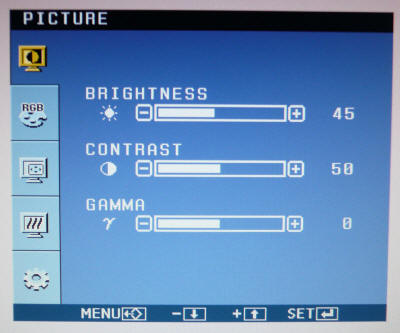
Above: OSD
menu
The OSD itself is pretty
standard, but the controls are not as intuitive as other screens we have tested
I felt. They aren't obviously labelled and so it takes a little time to
navigate. There are the usual options for brightness, contrast and RGB channels
as you would expect. There is also a preset gamma mode and colour temperature
modes, including sRGB and temperatures from 6500k to 9300k. The OSD control
buttons give quick access to the EZ-Zooming feature, f-Engine preset modes,
source (VGA vs. DVI) and 'Auto' config for analogue signals.
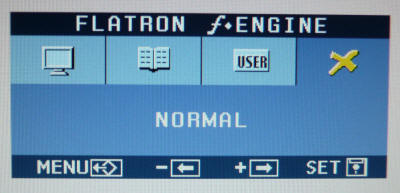
Above: OSD
menu for f-Engine presets
The f-Engine preset modes
available are 'Normal', 'Movie', 'Text' and 'User', each offer varied
brightness, contrast and colour settings. Some modes also enable the screens
dynamic contrast ratio (LG's
Digital Fine Contrast - DFC).

The EZ-Zooming feature allows
you to quickly switch between screen resolution modes to immitate zooming in on
text and images. Not really something many will find useful I shouldn't think,
and more of a gimmick than anything.

Colour Quality and
Accuracy
The LG L227WT utilises a 6-bit panel with FRC
technology being used to boost the colour palette to a reported 16.7 million colours. The screen uses enhanced W-CCFL backlighting and so it's colour gamut covers
100% of the NTSC colour space according to LG's specification.
An
important thing to consider for most users is how a screen will perform out of
the box and with some basic manual adjustments. Since most users won't have
access to hardware colorimeter tools, it is important to understand how the
screen is going to perform in terms of colour accuracy for the average user. I
restored my graphics card to default settings and set it to its standard
profile. The L227WT was tested at default factory
settings out of the box using the
LaCie Blue Eye Pro and their accompanying software suite.
Default settings of the screen were 100 brightness and 70 contrast. Gamma mode
was left at 0, colour
temperature preset mode was set to 6500k and RGB levels were all left at 50. The
f-Engine mode was left on 'normal'.

LG L227WT - Default Settings


|
|
Default Settings |
|
luminance (cd/m2) |
334 |
|
Black Point (cd/m2) |
0.43 |
|
Contrast Ratio |
777:1 |
At default settings the screen was far too
bright. The manufacturer had left the OSD selection for brightness at 100 and
this made the screen pretty much unusable really without leading to eye strain.
Testing with our colorimeter revealed that luminance was a very high 334 cd/m2,
far above the recommended 120 cd/m2 for an LCD screen in normal lighting
conditions, and even higher than the specified 300 cd/m2. This was the first main problem immediately evident when you turned
the screen on. Secondly, you could tell that the colours were way out at the
default settings, looking very cartoony and fake, and with an emphasis on
looking vivid rather than accurate.
The probe revealed that our initial
impressions were correct, with dE being on average 5.7 and with a maximum of
9.7. As a reminder, the graph on the right hand side above shows
DeltaE (dE 94) values across 16 shades of colours as measured by the device.
In simple terms, the lower these bars are down the Y-axis, the better, in terms of
colour accuracy. For reference, LaCie describe the DeltaE readings as:
-
If DeltaE >3, the color displayed is significantly different from the
theoretical one, meaning that the difference will be perceptible to the
viewer.
-
If DeltaE <2, LaCie considers the calibration a success; there remains a
slight difference, but it is barely undetectable.
-
If DeltaE < 1, the color fidelity is excellent.
So clearly our observation
was correct, the colour accuracy was very poor out of the box overall. Aside
from that the colour is also measured in the CIE diagram on the left hand
side, where the black triangle represents the monitors colour space (its gamut), and stretches
considerably beyond the standard triangle for the sRGB standard colour space. LG list
the screen as having a gamut which covers 100% of the NTSC colour space, and
clearly outside that which standard backlighting can offer, only really
covering the sRGB space and equating to 72% NTSC.
Gamma was recorded as being a little out at a
reading of 2.0, not quite at the 2.2 which is the
default for computer
monitors, and the standard for the Windows operating system and the
Internet-standard sRGB colour space. Colour temperature was actually reasonably
good since the monitor was left on the 6500k preset mode, which is our target
temperature of daylight. The probe recorded actual colour temperature as being
6085k, but only 6% out from the desired value at least. Black depth at the
default luminance was a pretty average 0.43
cd/m2, offering a static contrast ratio of 777:1 which is pretty
respectable for a TN Film panel.
While the monitor certainly
offers a nice wide colour space, factory settings were poor and calibration
would be needed in order to get any real accuracy out of the screen, or indeed
make it useable in normal conditions.

LG L227WT - Calibrated Settings

|
|
Calibrated Settings |
|
luminance (cd/m2) |
121 |
|
Black Point (cd/m2) |
0.21 |
|
Contrast Ratio |
576:1 |
I calibrated the screen with
the LaCie colorimeter and software and the results were far more pleasing.
Luminance was perhaps the main problem with the screen at default settings,
and it was now corrected to a far more comfortable 121 cd/m2,
certainly more usable in practice as well. It should be noted that it was a
little hard to adjust the OSD brightness control to achieve a suitable
luminance reading since the software process had trouble identifying a
reasonable level before LUT alterations were made. During the calibration
process the OSD selections were adjusted to 45 brightness and 50 contrast, so
use those as a starting point if you can. At this new adjusted luminance, the
black point was recorded at an impressive 0.21 cd/m2. This was not
quite as good as the
Iiyama E2202WSV we tested recently, which is another 22" TN Film based
screen (0.16), but was a bit better than the
Acer AL2216W we tested last May (0.23), and the
ViewSonic VX2245WM from last April (0.26). All in all, a pretty decent
black point for a TN Film panel, and the 576:1 static contrast ratio was
decent enough after calibration.
During the calibration
process the RGB channels were adjusted in the OSD to 50, 32 and 45
respectively. This made a fairly obvious difference to the colours straight
away, even before the automated calibration stages took place. This would be a
god starting block to help improve things from factory settings at least. The
calibration then continued, and the final results were very good. dE was now
0.6 on average, with the screen offering excellent colour fidelity according
to LaCie's classification. dE max was 1.7, so only a slightly difference
between the requested and displayed colours which was in the red tones. Colour
temperature was now pretty much spot on at 6502k and gamma was corrected
nicely to 2.2 as well.
Testing the screen with a
colour gradient program revealed an interesting feature. It was easy enough to
spot some gradation in the darker tones which you may see on quite a few
screens. However, what was also noticeable was that LG have used some
spatial dithering mechanisms it seems to produce the 16.7m colour palette.
Some 'chess board' like checkered patterns were visible if you looked closely,
but only in the darker tones. It should be noted that in practice you are
unlikely to see this issue day to day.

Viewing Angles
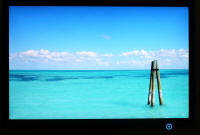
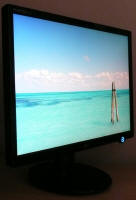



Above: Viewing
angles shown from front and side, and from above and below. Click for larger images
Viewing angles of the L227WT
were unmistakably TN Film! The screen showed the characteristic and obvious
blackening when viewed from below, as you can see from the above images. As you
moved your head vertically a white background would pick up a slight pink tint
when viewed from below, and a slight green tint from above. This became a little
distracting in office use since a white Word background would look uneven as you
glanced across the screen. At 22" in size, the screen is big enough for this to
be reasonably obvious, but I think it becomes more of an issue when you start
using 24" or bigger sized screens, and remain with TN Film panel technology.
Horizontally the viewing angles weren't too bad, but the contrast shifted
noticeably from about 40° away from a central point and the image became
'warmer'. If you are buying this screen you will hopefully realise that it is TN
Film based and know what to expect, but sadly the viewing angles don't offer you
much room to change your line of sight. A height adjustable stand may also have
been handy here to help set the screen at a sensible central field of view,
sadly it is lacking.

Panel Uniformity
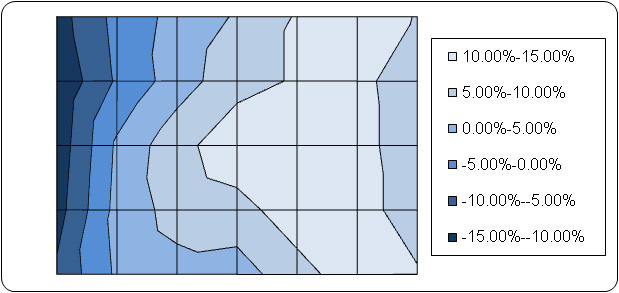
Measurements of the screens luminance were taken
at 35 points across the panel on a pure white background. The measurements were
taken using BasICColor's calibration software package, combined with the LaCie
Blue Eye Pro colorimeter. The above uniformity diagram shows the difference, as
a percentage, between the luminance recorded at each point on the screen, as
compared with the reference point of a calibrated 120 cd/m2. This is
the desired level of luminance for an LCD screen in normal lighting conditions,
and the above shows the variance in the luminance across the screen
compared with this point. It is worth noting that panel uniformity can vary from
one screen to another, and can depend on manufacturing lines, screen transport
and other local factors. This is only a guide of the uniformity of the sample
screen we have for review.
As you can see, the L227WT showed some variance of
about 15% both below and above the 120 cd/m2 luminance value. The
panel uniformity was average in this test, and the diagram shows that the left
side of the screen was a little darker than the right. In practice, you couldn't
really spot any issues with this. Viewing the screen with an all
black background showed no noticeable issues in terms of backlight leakage,
either from the corners or the edges, which can commonly be a problem with LCD
screens. The uniformity in this test appeared to be good.

Office and Windows Use
I've said it before, and I'll
say it again, a 1680 x 1050 resolution is nice for side by side office working,
but not quite enough to be really great. I think a 1920 horizontal resolution is
a nice step up, so consider whether you may benefit more from a 24" screen
perhaps, even if it is TN Film based. The 'text' f-Engine preset was actually
brighter than my calibrated 'normal' profile, and so pretty useless in my
situation. If you prefer a brighter default profile for gaming and movies (which
is what the screen is aimed at I suppose), then maybe the 'text' preset will be
useful. I would have preferred it to be a bit darker than it was.
The screen offers both analogue
(D-sub) and digital (DVI-D) interface options. Switching between the two showed
that the VGA connection was actually of a very good standard, and it was very
hard to spot any real difference in picture quality or sharpness between that
and the DVI interface. The 0.282mm pixel pitch makes this screen nice and
comfortable for office use for prolonged periods of time, and especially for
those who prefer text size which is a little easier on the eye.
As I mentioned above in the
viewing angles section, when viewing a white background you can notice some
unfortunate colour tinting as you glance away from a central point of view. This
is an issue related to the viewing angles of the TN Film panel used, and is
characterised by a pink hue from below a central point, and a slight green hue
from above. Not something which will bother everyone, but a little more obvious
than some other TN Film panels we have tested. Interestingly the other LG model
we tested last year showed a similar viewing angle shift (LG
L1960TQ).

Responsiveness and Gaming
The LG L227WT was tested using the chase
test in PixPerAn, a good bit of software for trying to quantify differences in
real terms responsiveness between monitors. As a reminder, a series of pictures
are taken on the highest shutter speed and compared. The images below show the
best case example on the left hand side, and the worst case example on the right
hand side. This should only be used as a rough guide to comparative
responsiveness but is handy as a way of keeping a constant test of each screen.



The LG L227WT uses Response
Time Compensation (RTC) technology to boost the response time across grey
transitions, with the aim to improve responsiveness of the panel as a whole.
This 'overdrive' technology has been applied to a traditional 5ms rated TN Film
panel and boosts some G2G transitions to as low as 2ms (in LG's measurements).
The improvement in practice is obvious when compared using a common testing method.
The Acer AL2216W and Iiyama E2202WSV screens above are both 5ms rated, and
feature no overdrive / RTC technology. Even the best case example in the images
shows an obvious second ghost image of the moving car. When watching the screen
you can see this with the naked eye as well, and the movement of the car is not
as smooth. The LG L227WT is very similar fundamentally, except that RTC is being
applied to boost G2G transitions. This is important in pratice, not just on
paper, and the above images give an indication of the improvements made. The car
moves much more smoothly, and it is not possible to detect a second ghost
image with the naked eye. You can see some slight pale halo-ing behind the
moving car, which is related to some 'overshoot' of the RTC impulse. It is not
obvious to spot, but our camera picks this up and you will see a slight
pale patch behind the car. Regardless, it is clear to see that the application
of RTC here has really helped improve the responsiveness of the panel compared
with those models that do not feature such technology.



For comparison, I have also
included the tests above for the Samsung SM931C which also uses a 2ms G2G rated
TN Film panel and shows very similar performance to the LG L227WT. The NEC
20WGX2 has long been considered one of the most responsive panels in the market
and is actually AS-IPS technology based. The LG.Philips panel used in the NEC
also uses a heavy dose of RTC to boost the responsivenss of the panel, and so
this model can still be used as a reference for our response time tests.
To summarise, the LG L227WT
performs very admirably in these tests and clearly the 2ms G2G rated TN Film
panel used is well suited to gaming and fast multimedia content. Since the
screen is marketed in this way, this is an important result and LG should be
pleased that the screen can offer what it sets out to do.
Another thing to note is that
the screen does feature hardware level
aspect ratio control to a degree. This is nice to see, and good to see LG have even
listed this feature in their specification on the website. This is a positive
up-front approach which consumers should be glad to see. This aspect ratio
control offers an option for '4:3' aspect sources (games, external devices etc.) without the
screen always stretching the image horizontally.
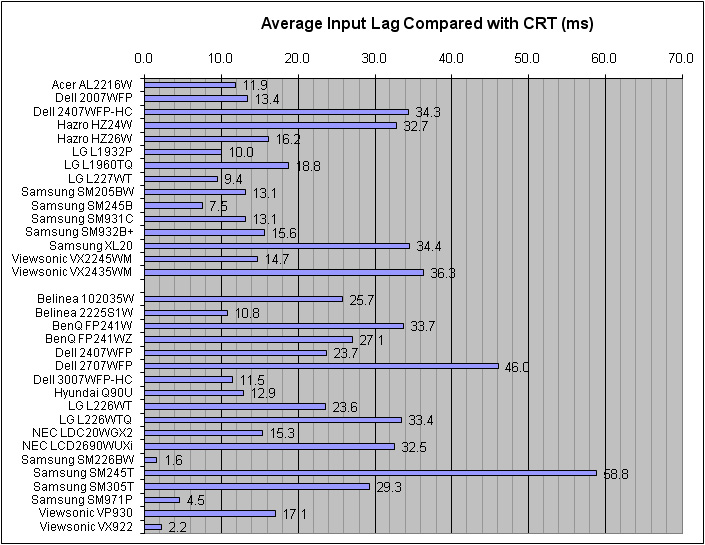
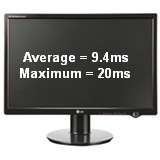

As usual I tested the
screen in clone mode with a CRT to determine the level of input lag. This is
something which can put off some gamers and is a delay between graphics card and
monitor output. By hooking up a CRT you can show that the LCD lags behind
somewhat, which can affect users in some situations where they rely on the
screen image being as fast as their inputs (e.g. fast FPS shooting games).
Often, input lag is very low and probably wouldn't represent too much of a
problem in real terms.
As you can tell from the
above, the LG L227WT was on average 9.4 ms behind the CRT screen. It should be
noted that in some instances the stop watch showed 0ms difference, but on some
occasions ranged up to 20ms. Overall, this was an admirable performance from the
L227WT and the input lag was minimal.

Movies and Video

The following summarises the L227WT's suitability
for movie viewing:
-
The screen size of 22" is decent enough for movie
watching, and the widescreen format is certainly preferrable to a standard
aspect ratio screen.
-
The 1680 x 1050 resolution is not quite enough to
offer a full true 1080 HD support, and you would need a resolution of at least
1920 x 1080 to offer this.
-
The digital interface is HDCP supported, and so
viewing encrypted content over this interface should not be a problem
-
The viewing angles of the screen are
characteristically TN Film, and so not really ideal for viewing movies.
Vertically the viewing angles are a challenge, and positioning the screen to a
suitable level is not easy when you're trying to watch from a distance away.
Perhaps a height adjustment would have helped here as well, but the panel
technology is not really ideal for this application. Vertically you will notice
contrast shifts which make it difficult to pick out detail in darker scenes.
-
Panel uniformity is good, and so there is no
obvious leakage from the corners or edges of the panel. This can be particularly
distracting when watching movies with black borders at the top and bottom, and
so thankfully the L227WT is free of this issue.
-
Responsiveness is more than enough to offer decent
performance in fast moving scenes
-
Colours look vivid and bright which is attractive
for movie viewing. Black depth is also good once calibrated, helping to ensure
detail is distinguishable in darker scenes.
-
The 'movie' preset mode might be handy to some,
along with the dynamic contrast ratio. This can help bring out detail in darker
scenes, and make lighter scenes brighter. Many people find this technology
annoying however, so it's down to personal preference.
-
The hardware based aspect ratio control can be
useful for viewing external sources which are not in WS format.
-
The screen isn't really the best in terms of
interface options. Perhaps an additional component or HDMI interface would have
been useful for connecting external DVD players or games consoles.
-
Movie noise is evident, being a heavily overdriven
TN Film panel. As usual, if you sit away from the screen a metre or two, you
won't really notice this.

Conclusion
LG have tried to incorporate
all the top-end specs in this 22" model and have done quite a good job. The fast
response time make this well suited to gaming certainly, and our tests reveal it
is very good in this regard. LG also market the screen at movie viewing which
the screen can manage to a degree. Ultimately the screen remains TN Film based,
and users will probably know what to expect. Viewing angles are restrictive and
limit the screens use in many applications including movie viewing. Colour
accuracy is poor at default settings, but if you are able to calibrate the
screen properly, you can actually get quite a lot out of this screen in this
regard, especially when you consider the extended colour gamut offered. All in
all, this is a good screen for gamers out there, and for those who don't mind
the sacrifices of TN Film technology. It offers a few extra features over some
other 22" models in the market at the moment (such as the DCR and extended
gamut) and so it can at least offer that little something extra if you want.
|
Pros |
Cons |
|
Fast response time thanks to RTC, good gaming
performance |
Lacking some ergonomic features such as a
height adjustment |
|
Extended colour gamut is a nice feature, and
colours can be accurate with calibration |
Poor default colour accuracy and settings |
|
Basic but attractive design |
TN Film technology results in limited viewing
angles particularly vertically |